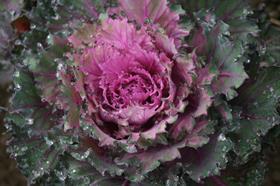
FPJ's Nina Pullman speaks to David Clay, brassica crop manager at Elsoms Seeds, and Tozer Seeds’ sales manager Robin Bartels.
What are your kale breeding programmes focusing on at the moment and why?
David Clay: Bejo breeding programmes are focusing on better general health of the plant, particularly in harsh growing conditions, improved yield and quality. All the Borecole (curly kale) we sell belongs to the Bejo Zaden seed house, while the Cavolo Nero (black kale) is supplied by Elsoms Seeds.
Robin Bartels: We are focusing on different types of coloured kales, as well as standard types, plus we are continuously focusing on flavour, texture and better growing characteristics of new kale hybrids. Successful Tozer product Flower Sprout has also been benefiting from the kale demand because this product is now widely available and will be branded as Flower Sprout kale in the UK going
forward.
What NPD have you got coming through? Are there any new varieties ready for commercialisation?
DC: We have red and green-leaved varieties, special assortment with improved frost tolerance and varieties adapted for mowing. Reflex is the main variety used in the UK, as it has an excellent yield and winter hardiness. Winterbor also sees good sales in the UK, while Redbor, our coloured offer, is a very good quality red kale.
RB: Buttonhole kale has been trialled commercially and this will be introduced on an exclusive basis in the UK in 2016. These kind of novelty varieties will entice more people to try kale since it will be easier to use, as it can be eaten raw, and it shows people that this is a truly innovative category. In my opinion these novelty varieties can be of great value in further developing the whole category.
What is the benefit of a coloured kale for a grower and for the industry?
RB: We are focusing on both standard and coloured kale varieties, to create better cooking characteristics and ways to process kales. To the grower this will provide a better yield and varieties that are easier to grow (less leaf damage, less waste), and for customers this will mean more choice in colour, leaf shapes and textures, which will broaden the reach of the kale category.
What is the demand for kale seeds like compared to previous years?
DC: In the UK we have seen a very strong demand for kale seed; we still have seed left available of certain varieties for sale. Furthermore in the rest of Europe, Bejo is seeing an increasing demand and initiatives to use kale in many different ways.
RB: The demand for kale seed and finished product (baby leaf and wholehead) has surged mainly in North America and the UK and Tozer has been ramping up breeding programmes and seed productions in the past years, hence we are ready to work with growers on the introduction of new kale varieties. Kale is also seeing a revival in north-west Europe and in many countries kale juicing is becoming more fashionable, which will also push sales of fresh kale.
Was there a seeds shortage last year, and is it likely to occur again this year?
DC: No, we have supplied all our customers with kale seed required from within the range of varieties available. All requests have been supplied and we still have stock available.
RB: There was a seed shortage last year but I expect that we will cope much better this year.
What do you think the future of the kale category holds? Do you see the growth plateauing at all, and, if so, when?
DC: There is a wide range of products available to the consumer with kale as an ingredient, plus the traditional offer is now sold by a greater number of businesses.
So at present sales look very strong, and with this product having a strong positive message, I believe we will see the trend continuing. Looking towards Europe there are many countries where there is hardly any kale consumption and they are also starting to see the benefits of this healthy, versatile vegetable.
RB: Year on year there has been a substantial growth of the kale category and the signs of this slowing down are not there yet. I think we will have a good few years of growth of the kale market ahead of us.



